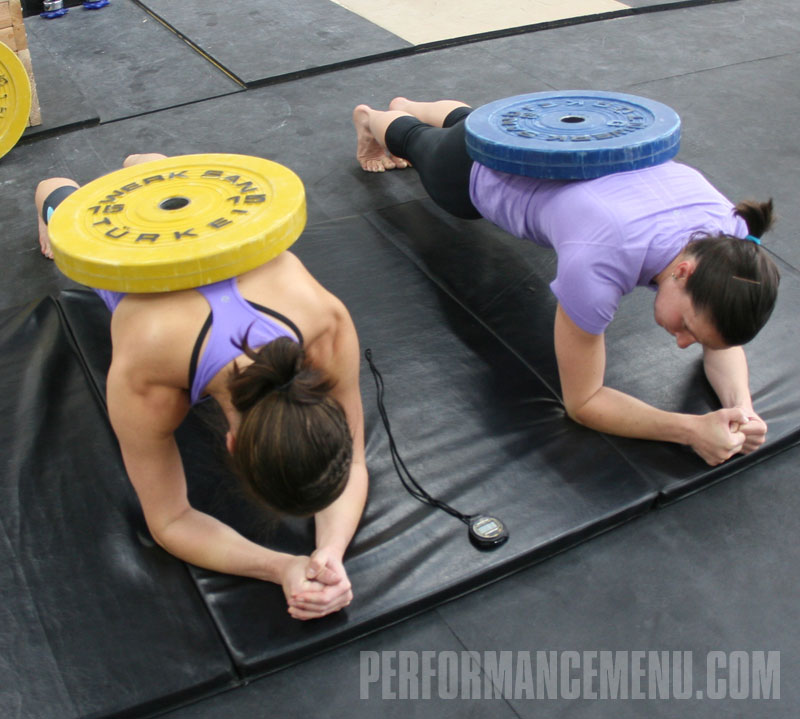How We Plank: A video Tour

There is a dogma that exists in the conditioning world that one only need squat and deadlift to train the core. Raise your hand if you agree.
There are a couple of issues with this current dogma. First, squatting and deadlifting with all populations is not only impossible, it’s likely negligent. The other issue lies with the fact that the anterior wall (rectus abdominis and obliques) and is not heavily activated.
In actual electromyography (EMG) work, we find that the deadlift and squat loads need be at near max. Deeper reading on this topic reveals that the spinal erectors are more activated than the rectus abdominis or the external oblique. So in fact the anterior wall is not as involved as many of us have been instructed.
With that being said, in my practice we still squat and deadlift knowing that we are conditioning other core musculature and associated linkage.
Since my groups are so large and my equipment limited, I could not create a challenging and enjoyable workout without my inventory of plank moves!
The Good About the Plank
Not long ago a reputable coach referred to the plank as an exercise for “stamp collectors.” Obviously, this coach had not done his GOOGLE search. Had he done so he would have learned a lot of research back in 2006 demonstrating that plank holds and side planks actually out performed squats and deadlifts on EMG measurements. Sign me up for stamp collecting 101.
By placing yourself in the plank position you actually strengthen the muscles for their purpose, which is to hold the spinal column in extension. Strong muscles of the core help to maintain a healthy spine.
My Plank Definition
Any position that is relatively horizontal to the deck in which the athlete is supported on the elbows or extended arms and resting on the knees or part of the foot. We use the front position, side position, and back positions. We sometimes toss in implements such as balls, core wheels, balance boards and my go to favorite, the dumbbell.
Progression and programming
I like to blend the plank into the workout I prescribe for the day. Harder more challenging planks are shorter in duration while more basic moves are longer.
My Plank Inventory
Since planking is so simple and writing is so boring, I thought it might be more entertaining to have a video tour to some of my plank variants. I believe you will find them quite to implement and entertaining for your athletes. Let me know if you have any questions.
WATCH VIDEO
There are a couple of issues with this current dogma. First, squatting and deadlifting with all populations is not only impossible, it’s likely negligent. The other issue lies with the fact that the anterior wall (rectus abdominis and obliques) and is not heavily activated.
In actual electromyography (EMG) work, we find that the deadlift and squat loads need be at near max. Deeper reading on this topic reveals that the spinal erectors are more activated than the rectus abdominis or the external oblique. So in fact the anterior wall is not as involved as many of us have been instructed.
With that being said, in my practice we still squat and deadlift knowing that we are conditioning other core musculature and associated linkage.
Since my groups are so large and my equipment limited, I could not create a challenging and enjoyable workout without my inventory of plank moves!
The Good About the Plank
Not long ago a reputable coach referred to the plank as an exercise for “stamp collectors.” Obviously, this coach had not done his GOOGLE search. Had he done so he would have learned a lot of research back in 2006 demonstrating that plank holds and side planks actually out performed squats and deadlifts on EMG measurements. Sign me up for stamp collecting 101.
By placing yourself in the plank position you actually strengthen the muscles for their purpose, which is to hold the spinal column in extension. Strong muscles of the core help to maintain a healthy spine.
My Plank Definition
Any position that is relatively horizontal to the deck in which the athlete is supported on the elbows or extended arms and resting on the knees or part of the foot. We use the front position, side position, and back positions. We sometimes toss in implements such as balls, core wheels, balance boards and my go to favorite, the dumbbell.
Progression and programming
I like to blend the plank into the workout I prescribe for the day. Harder more challenging planks are shorter in duration while more basic moves are longer.
My Plank Inventory
Since planking is so simple and writing is so boring, I thought it might be more entertaining to have a video tour to some of my plank variants. I believe you will find them quite to implement and entertaining for your athletes. Let me know if you have any questions.
WATCH VIDEO
|
Michael Rutherford (a.k.a. Coach Rut) is the owner of Boot Camp Fitness. He has over a quarter-century of fitness coaching experience with athletes of all ages. He has also worked in hospital wellness environments and rehabilitation clinics. Rut holds academic degrees in biology, physical education, and exercise physiology and sports biomechanics. He is a USAW-certified Club Coach and is a CrossFit level-3 trainer. |
Search Articles
Article Categories
Sort by Author
Sort by Issue & Date
Article Categories
Sort by Author
Sort by Issue & Date

